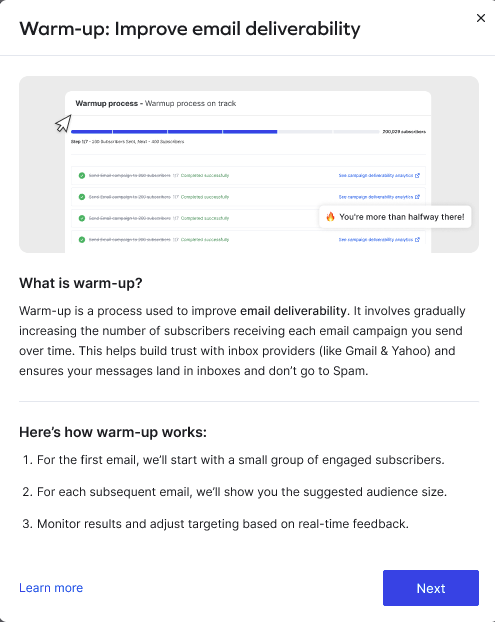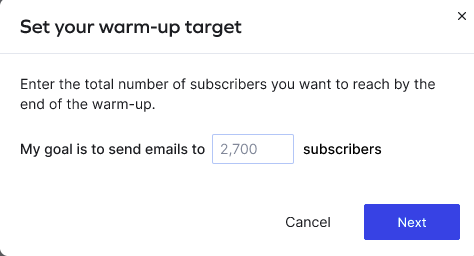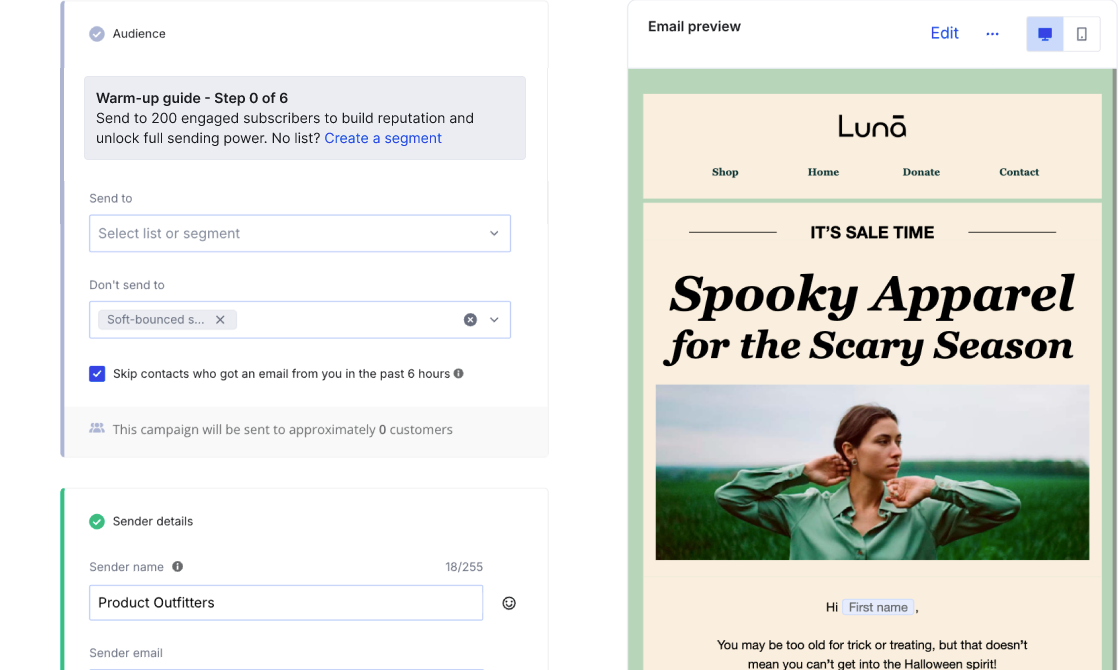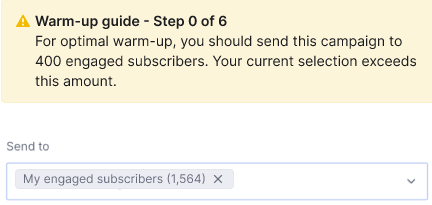- DarkLight
Beta: Warming Your New Domain Infrastructure
- DarkLight
Gradual Warmup Guide Overview
To ensure your emails reach inboxes reliably, warming up your sending domain is a crucial first step. When you add and authenticate a new subdomain, the Gradual Warmup Guide feature helps you increase your email volume over time in a safe, structured way. You'll start by sending to your most engaged contacts, then scale up as your sender reputation grows. This feature provides real-time insights into your warmup status, checks that your campaign audiences match your current stage, and offers guidance to help you stay on track. By including warmup in your onboarding, we help you avoid deliverability issues and protect your domain reputation from the very beginning.
Getting Started
The Gradual Warmup up will display after you completed the domain authentication. If you have not authenticated your domain, please do this before continuing.
Understanding the Warmup Process
The warm-up process takes approximately 2-4 weeks but will vary depending on your brand’s sending patterns and the feedback from inbox service providers (ISPs). During the warm-up process, subscriber lists must be prioritized due to the limited volume of emails to be sent. We recommend that you prioritize your lists by engagement levels so that your first campaigns go to your customers who most often open your emails.
This 2-4 weeks you will see our Warmup Guide to help you with the process.
Gradual Warmup Guide
Domain warming is the gradual process of building sender reputation. Yotpo’s Gradual Warmup Guide is a tool that automates and supports this process with clear stages and recommendations.
After authenticating your domain, you should see a popup to begin the Warm-up process. This popup is the first part of our automated warmup process.

Click the Next button to get started.
Setting Your Warm-up Target
You need to set the goal for how many of your subscribers you want to reach by the end of your warmup process. You can enter a minimum of 1 or up to a maximum of 1 million for your goal, but the goal must be set. We recommend setting your maximum to the usual amount of subscribers in your largest size campaign.

If you exit the popup without setting a goal, you will see the following prompt at the top of your My Campaigns page where you can re-enter the warmup process.

If you have already sent at least 4 email campaigns, you can opt to ignore the warm-up process however this can cause issues later on if your campaigns have low deliverability. Click the Ignore warm-up button. Then click to confirm ignoring the warm-up.
Note
If you have already sent campaigns with high enough deliverability, you won’t see the pop-up.
Important
Ignoring the warm-up is irreversible, once you choose this, you will no longer have access to the warmup wizard without contacting Support.


Next you need to construct your audiences to send your campaigns.
Constructing Your Domain Warmup Audience
Choosing the right audience is key to a successful warm-up. To build a strong sender reputation, start by sending campaigns to subscribers who are most likely to engage with your emails. Focus on your most active and loyal contacts, those who have recently made a purchase, are part of your VIP list, belong to your Yotpo Loyalty program, or have recently clicked or opened one of your emails. These high-engagement segments help ensure your emails land in inboxes and set a solid foundation for future sends.
Using engagement data from other (your previous) email marketing platform
If you have recent email engagement (clicked or opened emails) data from another email marketing platform, it is strongly recommended to harness it for your domain warmup. This requires the following process:
Export engagement-based subscriber lists from your previous email marketing system, according to this logic:
Engaged in the last 30 days
Engaged in the last 31-90 days
Engaged in the last 91-180 days
Use a spreadsheet (or another tool) to break down the lists so they fit the campaign schedule requirements:
For example, if your “engaged in last 30 days” list size is 7,500, break it down to sub-lists of 500, 500, 1,000, 2,000, and 3,500.
It will be easier if the lists do not overlap, meaning a subscriber will appear in one list at most.
Import those lists into Yotpo email marketing, giving the lists ‘meaningful’ names like:
List name | List contents |
|---|---|
Engaged_last_30_500_1 | 500 subscribers engaged in the last 30 days |
Engaged_last_30_500_2 | 500 subscribers engaged in the last 30 days |
Engaged_last_30_1000 | 1,000 subscribers engaged in the last 30 days |
Engaged_last_30_2000 | 2,000 subscribers engaged in the last 30 days |
Engaged_last_30_3500 | 3,500 subscribers engaged in the last 30 days |
Create campaigns using one or multiple lists to build the correct audience from both engagement and volume POV.
Using purchase data and previous segmentation data
If you have no email engagement data with us or from another ESP, you can still achieve good warm-up results by using past purchase data. In this method, you can select the audience for your first few campaigns by looking for:
Subscribers who made a purchase in the past 30 days. You may choose to exclude those who made a purchase in the past 7 days, to prevent user fatigue.These can be further tiered by spend and/or number of purchases.
Subscribers previously segmented into high-value segments like “VIP Customers”
If you are also a Loyalty customer, you may leverage that by choosing your loyalty members, and even break it down by loyalty tiers
After a few campaigns, you will automatically switch to the next phase - using Yotpo Email Marketing engagement data.
Using Yotpo Email Marketing engagement data
Once you have accumulated enough email engagement data with Yotpo, you can use our rich segmentation capabilities to define the correct audience for each of the warmup stages. You will have to make sure your segments are not too wide, so you don’t vastly exceed the recommended audience size for each. For example, for your 5th campaign, if your segment for “clicked a link and/or made a purchase in the last 90 days” yields an audience of 7,500, you may narrow the 90 to achieve an audience closer to the desired 5,000.

After creating your audiences, you can create your email templates and campaigns. See our articles on Email Customization and Templates to learn more on designing your campaigns. When setting up your campaigns, our Warmup wizard will prompt you to add your audiences and let you know when you have selected an audience that doesn’t match the subscriber goal for the campaign.
Before Audiences are Added

After Audiences are Added

Audience too Large

Expanding Your Warmup Audience
After sending your first high-engagement campaigns, you can begin sending a few campaigns targeting less engaged segments, along with more engaged segments. Throughout the whole warm-up, send your best-performing, most engaging content to get the best results. If you send to inactive subscribers, you will risk low email engagement and spam folder placement by ISPs such as Gmail, Microsoft and Yahoo.
Sending Your Campaigns
As you send your warm-up campaigns, you will see your progress bar fillup letting you know exactly where you are at in the process.



Once you have sent all of your campaigns, your warm-up is complete.
Monitoring Your Warmup Performance
Over the following weeks, monitor your performance and adjust your warmup accordingly. These are the recommended performance indicator targets before you progress between stages in the warming process:
Performance indicator | Target value |
|---|---|
Opens (unique) | ≥ 40% |
Clicks | ≥ 2% |
Hard bounces | ≤ 1% |
Soft bounces | ≤ 2% |
Unsubscribers | ≤ 0.3% |
Spam reports | ≤ 0.08% |
Note
During the warming process, it's possible to see a temporary decline in deliverability performance, such as lower open rates and more emails ending up in spam while the domain is building up reputation. For more information on improving email deliverability, see our Improving the Health of Your Deliverability Metrics article.
To help you work through the sometimes complicated process, we have developed this wizard to guide you through.
Common Errors
Low Engagement Detected
If we detect an open rate below 30% for a warmup campaign, you will see the message below. We recommend that you review the subject line and email content before resending the campaign to increase the open rate.

High Soft Bounce Rate
If we detect a soft bounce rate above 2% for a warmup campaign, you will see the message below. We recommend that you review your lists to improve your sender reputation.

High Hard Bounce Rate
If we detect a hard bounce rate above 1% for a warmup campaign, you will see the message below. We recommend that you clean your lists to remove any problematic emails.

Sending Error
If we detect a sending error for a warmup campaign, you will see the message below. We recommend that you repeat the last step to continue the warmup.

FAQs
Can I send flows during the first week of warm-up?
Send only high-engaging flows, for example, welcome flows, abandoned cart, and browse abandonment.
Should I use win-back or re-engagement flows during the initial warm-up period?
Turn off win-back or re-engagement flows during the first week.
Can I send regular email campaigns during the warm-up process?
You can send non-warming campaigns while going through the warm-up process, however, if a campaign is sent to more subscribers than allowed for the current warm-up stage, the campaign will not count toward the warm-up. This is not recommended due to the deliverability risks for high bounces and low engagement which can negatively impact the effectiveness of your warmup.


